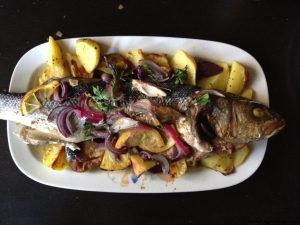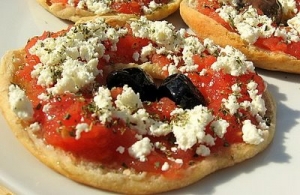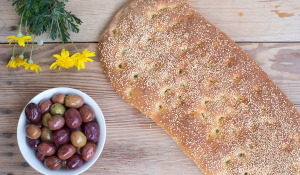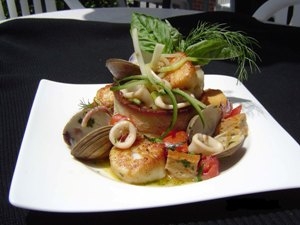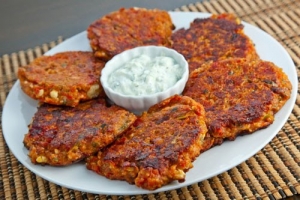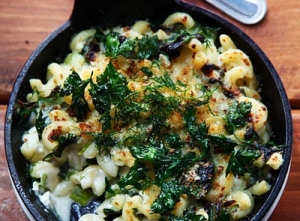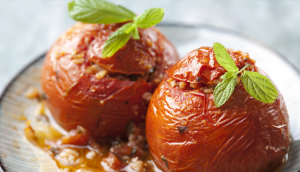ABOUT US
XpatAthens
Sea Bass With Lemon And Potatoes
In Greece, summer is always combined with good fish. The last time I was in the local market I got a large sea bass to cook. I have to say that it is not an easy task to cook a big sea bass but its sure worthwhile. Well, so how do you do it? Hmmm… I guess there are different ways but usually I love putting the fish in a foil and baking paper to cook it. It makes the fish cook really nicely and keeps all the flavours and taste. The following is a simple recipe I think that anyone can do and cook a nice fish without a lot of trouble as the only thing s/he needs to do is …leave it in the oven!
INGREDIENTS FOR OVEN BAKED SEA BASS WITH LEMON
1 LARGE SEA BASS (enough for 2)
1 onion chopped in large pieces
2 cloves of garlic chopped
A small bunch of parsley
Aluminium foil and baking paper
Salt and pepper
Oregano
2 potatoes
1 teaspoon mustard
Olive oil
Step by step for baking our sea bass
Ask the fisherman to clean our sea bass as it’s a bore to do it by ourselves.
Add salt pepper on all sides of the fish.
In a glass we add a teaspoon of olive oil together with the juice from half of a lemon and add a little bit of water. Add our sauce to all of the sides of the fish spreading it with your hands.
In a big baking pan we add on top a big piece of aluminium foil and then on top of it we cover it with the baking paper.
Place the fish on the middle and add on top of it and inside its belly, the onions and the garlic. We add also slices of half of a lemon.
We cover the fish with the aluminium foil and the baking paper so it can be covered from all sides keeping the juices in.
Put it in a preheated oven (220C) for 45 minutes to 1 hour.
For the potatoes
Cut the potatoes in small pieces and place them in a baking pan.
Mix in a glass the juice from the lemon that has remained together with olive oil a teaspoon of mustard, oregano and water. Stir them really well and spread the sauce on all the potatoes and mix them using your hands.
Place them in the oven.
Ideally you should put them in at the same time and time it correctly. Usually it takes 30 minutes for the potatoes –if they are cut into small pieces.
Add the parsley at the end when you serve it.
To read more, please visit thegreekfood.com
The Original Cretan Diet
The island of Crete lies 200 miles south of Athens and 160 miles North of Libya. It is the largest of the Greek islands with a land size of 3216 square miles. The Cretan diet forms the basis of the Mediterranean Diet and is said to be one of the healthiest in the world.
Based on The Seven Countries Study which took place during 1958 to 1970, it was discovered that the control group of 700 rural Cretan men had exceptionally low death rates from heart disease, despite moderate to high intake of fat, and lived to a ripe old age.
The type of fat was olive oil and the beneficial health effects are due to the oil’s high content of monounsaturated fatty acids and antioxidants.
The Cretan people were mainly land owners, farmers, and rural agricultural workers. Traditionally living off the land, gathering wild herbs and fruits, growing their own vegetables and raising animals for meat – particularly chickens, lambs and goats.
To read more, please visit Carolinacrete.hubpages.com
Lagana–Traditional Bread For Clean Monday
Lagana bread holds a special place in Greek culinary tradition, particularly during Clean Monday, the first day of Lent in the Orthodox Christian calendar. This flatbread's origins trace back to ancient Greece, where it was made from barley flour and served as a staple food.
Clean Monday, known as Kathara Deftera in Greek, marks the beginning of Lent, a period of fasting and spiritual reflection leading up to Easter. Lagana bread became associated with this day as it provided a simple yet satisfying meal that adhered to the fasting guidelines, which prohibit the consumption of animal products, including dairy and eggs.
One notable feature of lagana bread is its texture, which is dense yet soft. It is traditionally baked without the use of yeast, resulting in a slightly crumbly consistency. Moreover, lagana bread is unique in that it is not sliced with a knife. Instead, it is torn by hand into irregular pieces, symbolizing humility and mindfulness during the fasting period.
For a tasteful recipe for lagana bread, please visit: dianekochilas.com
Greek Fish And Seafood
If you take a look at a map of Greece you will see why fish is such an important part of the Greek diet. For such a small country there is a lot of coastline which is why they have such a strong history of seafaring.
Eating seafood goes along with that. Unfortunately the sea which was once so abundant is now barren in places through over-fishing and the Aegean sea simply can't keep up with the demand of a seafood-loving population whose numbers swell during the tourist season. Fish can be very expensive, though there are inexpensive fish available year-round, and these are just as tasty as the expensive ones.
Lets start at the bottom and make our way up the fish chain. The cheapest fish are sardeles (sardines), gavros (anchovies), kolios (mackerel), gopa (bogue) and marides (smelt). Also in this inexpensive category are kalamari (squid), though the frozen variety which is usually, if not always, imported from California, China and other far away places. When kalamari is in season they will tell you on the menu that it is fresh. When cut and fried it is usually frozen but fresh kalamari is grilled or fried whole. In the kalamari family is also thrapsala which to you and I looks like a squid and tastes like a squid but is not a squid. Well maybe it is a squid but they call it thrapsala and like fresh kalamari they serve it grilled or fried whole. In the same family are soupia (cuttlefish) which have shorter tentacles and are never fried but cooked in a stew with tomato sauce. Octopus, which is eaten in small amounts as a meze (snack) can be local or can come from China or the Atlantic. Octopus can be served in a number of ways which I will go into later. In between there are a number of fish whose price depends on supply and include xifia (sword fish), a couple varieties of Mediterranean tuna, and a whole family of bream, trout and even mollusks. Included among them is fagri (red porgy), sargos (sea-bream), lavraki (sea bass), lithrini (pandora), and synagrida (dentex) most of which are either baked or grilled and sold by the kilo.
Then at the top of the fish food chain is astakos (lobster), which can cost a small fortune and is familiar to anyone who has taken a charter sailboat around the islands because many skippers take their clients to the tavernas that serve fresh lobster or the newly popular astako makaronada (macaroni with lobster). Not surprising since skippers often get a commission from the restaurants for any business they bring and a table full of lobster can cost a few hundred euros or more. But here's a tip. Save your lobster-money for home. Mediterranean lobsters are over-rated, under-tasty and few chefs have mastered the cooking of these creatures. They also lack claws which besides the tails are the only edible part unless you want to spend the night sucking bits of meat from legs and antennae. Yes. The Greek lobsters have meat in the antennae. But not enough to justify eating them. In Milos I did see lobsters with claws at the restaurant of the famous Roberto at Da Peppe. "Where did you find lobsters with claws?" I asked him in wonder. "On the airplane" he said in his broken English. They were flown in, maybe from Maine, definitely from somewhere on the Atlantic.
To read more, please visit greecefoods.com
Best New Greek Wines: Red
Greek white wines may be more consistent, but the best Greek reds are fantastic. Here are nine terrific bottles.
2006 Pavlou Estate Klima
The Pavlou Estate in the Amyndeon region focuses on Xinomavro, the great red grape of northern Greece. (The winery even creates an intriguing white blend from it by crushing the grapes, then immediately discarding the skins.) This 100-percent-Xinomavro bottling shows off the variety’s distinctive dried-cherry flavors and streamlined tannic structure.
2004 Katogi & Strofilia Agiorgitiko
Dark cherry and espresso notes characterize this focused Agiorgitiko, which comes from a wine producer based in Macedonia. (One of its founders, Evangelos Averoff, was also the first winemaker in Greece to plant Cabernet Sauvignon, back in the ’50s.)
2007 Kir-Yianni Paranga
Yiannis Boutaris founded Kir-Yianni in 1997 after leaving Boutari, the company his grandfather founded in 1879. Since then, Kir-Yianni has become one of Greece’s top producers on the strength of wines such as this peppery Xinomavro blend, distinguished by its juicy cherry-berry flavors.
2006 Pavlidis Thema Red
Located in a narrow valley in the northern Greek region of Drama, the small, ambitious Pavlidis Estate creates a focused range of top-quality wines from hand-harvested grapes. This violet-hued blend of Syrah and Agiorgitiko combines peppery, gamey aromas with rich black-fruit flavors.
2005 Skouras Megas Oenos
George Skouras, this estate’s owner and winemaker, was among the first in Greece to blend international and local grape varieties. This bottling, which is largely old-vine St. George (an alternate name for Agiorgitiko) with about 20 percent Cabernet Sauvignon, has bright berry fruit with a note of blackberry liqueur.
2005 Tselepos Cabernet-Merlot
Yiannis Tselepos, one of the central figures of the Greek wine renaissance, started his Peloponnesian winery in 1989 after studying enology in Dijon, France, and working for several years in Burgundy. Known for his graceful Moscofilero white, he also makes this smoky, elegant red, full of black-currant fruit.
2004 Palivou Estate Terra Leone Ammos
This voluptuous, rosemary-scented Agiorgitiko, lush with potent black-cherry fruit, comes from fourth-generation proprietor—as well as first-generation winemaker—George Palivos. For this high-end bottling, grapes from a single vineyard Palivos owns high in the Neméa valley receive lengthy aging in French oak. Somehow, though, the oak notes don’t dominate the flavors of the wine.
A Delicious Vegetable That’s Hard To Beat
It’s hard to beat the nutritional power of beets. Although they’re available year-round at the grocery store, right now – late summer though early fall – fresh, locally grown beetroots are at their peak. Beets offer plenty more than just flavour. They’re colourful, nutritious and packed with disease-fighting phytonutrients. Red beets owe their deep crimson hue to betaine, a natural compound thought to help guard against heart disease and cancer.
It is betaine that causes some people to pass reddish coloured urine, called beeturia, after eating beets. It’s a harmless side effect that will subside once the food leaves your system.
Betaine acts as an antioxidant and also helps fight inflammation in the body, a risk factor for many chronic diseases. Research has shown that people who consume the most betaine from foods – versus the least – have lower blood levels of inflammatory immune compounds, including C-reactive protein.
Beets are good for your liver, too. That’s because the liver uses betaine to neutralize toxins so they can be removed from the body. Beets also offer plenty of folate, a B vitamin used to create and repair DNA and make red blood cells. And beets are a good source of potassium, a mineral that helps keep blood pressure in check.
It’s true that beets have more natural sugar than other vegetables (although considerably less than fruit), but they are still low in calories. One-half cup of cooked beets, for example, delivers only 37 calories. (The same serving size of broccoli has 27 calories.)
If long cooking times deter you from eating beets more often, oven roast or boil whole, unpeeled, scrubbed beets in advance. That way it takes only a few minutes to heat them or add them to a salad. Or, cut unpeeled medium-sized beets into quarters and steam them for 15 minutes. You can also grill slices of raw beets, brushed with olive oil, for eight to 10 minutes per side.
Per serving, cooked beets have nearly twice as much betaine as raw beets. Folate and potassium are similar for cooked and raw beets, provided you cook them in their skin.
Don’t stop at the beetroot. Beet greens are also packed with nutrition, in particular beta-carotene and lutein, an antioxidant that helps maintain healthy vision. Toss washed beet greens into salads, add them to soups and pasta sauces, or sauté them in olive oil and crushed garlic until tender.
Beet nutrition
Per 1/2 cup of cooked, sliced red beets:
37 calories
0 grams fat
1.7 grams fibre
6.7 grams sugar
259 mg potassium
68 mcg folate
217 mg betaine
Beets seven ways
Go raw. Add grated raw beets to salads, coleslaw and wraps.
Blend. Purée chopped, cooked beets into a fruit or green smoothie.
Roast. Include beets in a medley of oven-roasted root vegetables, such as carrots, parsnips and turnips. Beets take longer to cook than other vegetables, so pre-roast them, then add to the other vegetables near the end of their cooking time.
Sauté. Heat chopped, precooked beets in olive oil with freshly squeezed orange juice and grated orange rind. Garnish with chopped chives.
Toss. Serve sliced roasted or grilled beets over a bed of greens. Add orange slices, toasted walnuts and a sprinkle of feta or goat’s cheese.
Slurp. Enjoy a bowl of borscht, a traditional Russian soup made with beets.
Snack. Bake beet chips by tossing peeled and thinly sliced beets (use a mandolin) with olive oil. Spread slices evenly on a baking sheet; bake at 200 C until crispy. Sprinkle with sea salt.
By Leslie Beck
Chocolate Cake With Yogurt, Olive Oil And Vyssino
January 6th, was a major Greek holiday, the Theophania. Sometimes it’s called Little Christmas or the Epiphany. Happy belated name day to all the Fanis, Fotis, Foteinis, Jordans, and Theofanis of the world! Maybe you’d like to celebrate with an easy Greek recipe, too, for chocolate-yogurt cake with sour cherry (vyssino) preserves!
Ingredients
2 ½ tbsp olive oil, plus a little bit more for the pan
3 tbsp butter, soft and unsalted
1/3 cup cocoa powder, sugar-free
3/4 cup all -purpose flour
3/4 tsp baking powder
2/4 tsp salt
1/4 tsp soda powder
1/2 cup Greek strained yogurt
2 ½ tbsp water
1/2 scant tsp vanilla powder
2/4 cup sugar
1 large egg
Sour cherry sweet preserve as topping
Instructions
Place the rack in the middle of the oven and preheat to 375F/180C.
Butter a round cake pan 10-in./22.5 cm in diameter and sprinkle with cocoa powder.
Mix the flour, 2/3 cup cocoa powder, baking powder, soda, and a little bit of salt in a bowl.
In another bowl, whisk the yogurt, water, and vanilla.
Combine the olive oil, butter, and sugar in the large mixer bowl, on medium speed, until the mixture very fluffy and pale yellow.
Add the eggs one by one, beating all the while.
Turn the mixer to low speed and add half of the flour mixture.
Pour in the yogurt mixture and the remaining flour mixture. Beat all the ingredients together until smooth and combined, and then transfer to the cake pan.
Bake the cake for about 30-40 minutes. Insert a toothpick in the center to test it for doneness. If it comes out clean, the cake is baked.
By Diane Kochilas
Ntomatokeftedes (Greek Tomato and Feta Fritters)
When I came across a tomato version otherwise known as ntomatokeftedes or Greek style tomato and feta fitters on Kopiaste I just had to try them and now was the perfect time with all of the perfectly ripe field tomatoes around. These tomato fritters get their tomato flavour in the form of ripe tomatoes and a couple of sun dried tomatoes are also tossed in for even more tomatoy goodness. One of the things that I really liked about the zucchini fritters was that they used a lot of fresh herbs and these tomato fritters use just as much. Another thing that I like about this recipe is the use of the bulgur wheat which makes them a bit healthier.
(makes 4 servings)
Ingredients:
4 large tomatoes (peeled, seeded and diced)
4 sundried tomatoes (chopped)
4 ounces feta (crumbled)
1/4 cup herbs (such as dill, mint, parsley, chopped)
2 green onions (sliced)
1 teaspoon oregano
1 teaspoon paprika
2 eggs
1/4 cup fine bulgur wheat
salt and pepper to taste
1 cup whole wheat flour
* whole wheat flour
2 tablespoons olive oil
Directions:
1. Mix the tomatoes, feta, herbs, green onions, oregano, paprika, eggs, bulgur, salt and pepper in a large bowl.
2. Slowly mix in some whole wheat flour until the mixture becomes thick enough to form into patties.
3. Heat the oil in a pan.
4. Form the tomato mixture into patties and fry in the oil until golden brown on both sides, about 4 minutes per side.
Author: Kevin Lynch
www.closetcooking.com
Greek Mac And Cheese
I got a little inarticulate when confronted with this Greek mac and cheese. All I could say to myself was: Looks good. Looks really, really good. Um, do I have any feta? This recipe puts a spin on mac and cheese. In some ways it's straightforward: there is a béchamel sauce of cheese, milk, and flour, and the pasta is familiar macaroni.
But then we get mix-ins of gently cooked shallots and spinach, and a healthy helping of dill. The whole dish is finished with toasty breadcrumbs and crumbled feta cheese.
INGREDIENTS
3 slices crustless white bread, torn into small pieces
9 tbsp. unsalted butter, melted
Kosher salt, to taste
200 gr hollow pasta, preferably elbow macaroni
1/4 cup flour
3 cups milk
4 cups grated graviera or kefalotyri cheese (about 350 gr)
3/4 tsp. ground cinnamon
1/8 tsp. freshly grated nutmeg
Freshly ground black pepper, to taste
2 tbsp. extra-virgin olive oil
8 large shallots, finely chopped
16 oz. baby spinach, roughly chopped
8 scallions cut into 1/4"-thick rounds
1/3 cup roughly chopped fresh dill
1 3/4 cups crumbled feta (about 350 gr)
INSTRUCTIONS
1. Put bread into the bowl of a food processor and pulse until finely ground. Put bread crumbs and 3 tbsp. butter into a small bowl and combine; set aside. Bring a large pot of salted water to a boil. Add pasta and cook until cooked halfway through, about 3 minutes. Drain pasta, rinse with cold water, and set aside.
2. Heat remaining butter in a saucepan over medium heat. Add flour and cook, whisking constantly, for 1 minute. Still whisking constantly, slowly drizzle in milk and cook until sauce has thickened and coats the back of a spoon, 10–15 minutes. Remove pan from heat. Stir in graviera, cinnamon, and nutmeg and season with salt and pepper; set béchamel sauce aside.
3. Heat oven to 180°. Heat oil in a pot over medium heat. Add shallots and cook, stirring often, until soft, 3–4 minutes. Add spinach and scallions and cook, covered, stirring occasionally, until wilted, about 3 minutes. Stir in the reserved béchamel sauce, the dill, and the reserved pasta and transfer mixture to a 22cm x 30cm baking dish. Sprinkle evenly with reserved bread crumbs and the feta. Bake until golden brown and bubbly, about 30 minutes. Let cool for 10 minutes before serving. Serves 8–10.
For more information, please visit Sources: www.thekitchn.com and www.saveur.com
Gemista – A Beloved Summer Dish
Gemista or stuffed tomatoes is a beloved vegetarian summer dish and one of the most famous Greek specialties in the world.
Even though making gemista might seem a bit complicated at first, it is pretty easy to make, and once you've learned the steps, you can get playful and improvise. There are many variations for this recipe across the country; some include ground beef, some contain raisins and pine tree nuts, while others include grated zucchini. Here's a simple yet flavorful recipe to introduce you to this delightful Greek dish!
Serves: 5
Difficulty: Moderate
Cooks in: 1 hour 20 min
Ingredients
• 10 tomatoes (large, ripe, and plump)
• 2-3 potatoes cut into wedges
• 2 onions finely diced
• 2 large garlic cloves finely chopped
• 1 tablespoon tomato puree
• 1+1/2 cups rice
• 1/2 bunch parsley
• 1/2 bunch mint
• 1 cup olive oil
• salt and pepper
Cooking Instructions
1. Wash the tomatoes thoroughly and cut a 2cm slice off the top of each one, next scoop out the pulp with a teaspoon into a bowl and set aside.
2. Add the grated onions, garlic, herbs, rice, and tomato puree to the bowl.
3. Add salt, pepper, 3/4 cup olive oil, and mix to make the stuffing.
4. Stuff each tomato with the rice mixture, being careful not to overfill as the rice expands when it boils.
5. Arrange the stuffed tomatoes in a baking dish, add the potatoes, some olive oil, and a bit of water.
6. Add some salt to the potatoes, cover the baking dish with aluminum foil, preheat the oven to 180 c and cook for about an hour.
Tip
Add water as needed so that the rice doesn't dry out and take off the foil half an hour before taking the food out of the oven.

